Physical Training For Youthful Aging
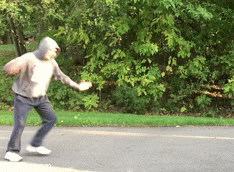
Physical decline is expected as we get older right? Wrong! At Cats & Kilos we strive to prevent this as much as possible. Why not train for youth? This means we need to focus on the areas that would typically decline over time such as strength, speed, explosiveness and balance while maintaining cardiovascular fitness. Below are exercises to help improve these physical attributes.
Yes, that's me in the GIFs on this page in my mid-50's trying to follow my own advice. Give me a break, I'm not a gymnast!
Strength Training
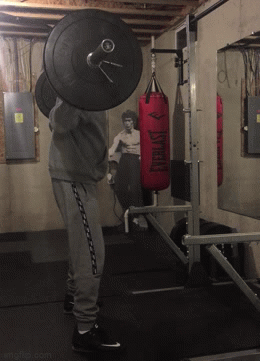
Squat Variations
This is one of the best exercises to improve and maintain overall body strength, especially leg strength. However, due to mobility issues or other limitations, not everyone can do traditional barbell squats with a loaded bar. The good news is that there are enough squat variations and modifications available that almost anyone of any age can find one that is appropriate for them. Always check with your doctor to ensure that you are cleared for any exercise you are considering.
Chair Squats
Use a chair to do the squat movement. As soon as you are about to sit down, get back up. If this is too difficult you may use the arm rest of a couch so you don't have to go as low.
Regular Bodyweight Squat
Do a set of squats with just your body weight using the same form as you would if sitting down on the toilet. If you can, go down until your thighs are parallel to the floor (otherwise just as far down as you comfortably can) and get back up. To examine your form you may use your phone to record yourself as, if you've never done this before, it will probably feel like you are going lower than you really are.
Barbell Squats
You may do squats for repetitions with just the bar or add weight if this is too light for you. This can be used at the highest levels of physical performance; however, as we get older, it is generally recommended to avoid trying maximum intensity lifts in the lower rep range unless this is performed with an appropriate intensity taper over several weeks by experienced lifters that are in good enough physical condition to avoid injury.
A Great Full Body Resistance Training Workout
Gain Strength & Help Maintain Bone Density & Muscle Mass with This Workout
Work All Your Major Muscle Groups with This Simple Workout
Speed and Explosiveness
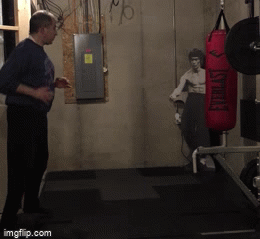
Speed and explosiveness are not things you would typically associate with aging. Generally, the older we get, the slower we get. We can't move as fast, run as fast or jump as high. This is the very reason, I believe, we should train for speed and explosiveness as we age! Of course, not everyone will be a good candidate for aggressive movements; however, let's keep in mind that things can be RELATIVE. For someone with significant limitations, it may just be trying to stand up a little faster from a chair - even this should be discussed with your health care providers and should be under supervision in certain cases as this may increase the risk of falling in the beginning. However, over time, it will allow better reaction time to events that are out of our control. Imagine slipping on ice for example. One of the reasons older people sometimes fall is because of difficulty in the body reacting quickly enough to maintain balance. The following exercises can be helpful in building and maintaining speed of movement at a variety of age and ability levels.
Squats With Explosive Ascent
Although this seems like something only an athlete would do, keep in mind this "explosive" is a relative term. If you are older with limited mobility, how about trying to just do a "quarter squat" with only your bodyweight - only going 1/4 of the way down - and returning to the standing position as quickly as you can. You should just do some slow quarter squats to start with and slowly increase how quickly you stand. In certain cases, you should do this under supervision or avoid this altogether if your physical condition does not allow it. Please discuss this with your health care providers.
For those that are in good enough physical condition, you can go lower and explode up off the floor. This can also be done while holding dumbells at your sides or a barbell on your shoulders. Depending on your goals, you can also try using a weight heavy enough to prevent your feet from leaving the floor as you try to jump but giving your best effort to do so anyway to build explosive strength. Of course, safety is key and doing this under the supervision of a qualified trainer is recommended.
Jumps
Along the same lines of the explosive squat, those in good enough condition may wish to SLOWLY work towards jumping as high as they can. This should be a gradual process over a few weeks before going all out to reduce the risk of injury. You may think that injury is unlikely but, in addition to patellar and achilles tendon strains, hip and knee joint injuries as well as back and other injuries, tendonitis may start to develop if your tissue does not adequately get accustomed to this high impact movement. Coordination will slowly improve over time to minimize the chance of landing on your heels (you should try to "land softly" on the balls of your feet, not your heels!) or in an otherwise awkward manner. Eventually, you may want to test your standing vertical jump ability, running vertical jump and so on. Many older people are unable to jump onto the curb of a street so maintaining this over the years puts you ahead of the curve.
Olympic Lifting
Movements like the Clean & Jerk, Snatch, Power Snatch and variations are designed to make the body move as quickly as possible against resistance. This may be the ultimate in explosive movement but, again, they can be modified for most fitness levels. You may wish to talk to a qualified instructor to learn these complex movements; however, even if you can perform them with only minimal weight, the mobility that they can help maintain will likely be worthwhile. As these are advanced movements, people with certain limitations or high injury risk (such as those with certain rotator cuff problems) may find the risk/benefit ratio does not make these worth doing and, in these cases, they should probably be avoided.
Martial Arts
There are so many martial arts that you will likely find one to suit your needs. Although Tae Kwon Do, Karate, Boxing and other striking arts can be used to maintain speed of movement and may be performed explosively, the degree of "explosiveness" is relative from person to person. This allows people with different physical abilities to still get value from the same movements. The key is improving only relative to yourself, not someone else. The great part is that if explosive movements are contraindicated in your case due to physical limitations, injuries, etc, you can chose a slower moving art - Tai Chi, etc - where you will still benefit from the sustained positions and can maintain some degree of joint mobility with a much lower risk of injury. You don't want to go to a martial art school? You don't have to! Just look online at some different styles and try practicing some movements on your own. Yes, ideally you would learn a martial art under supervision but, for our purposes, starting slowly on your own is still much better than nothing. We are not trying to make you a fighter, we are just looking for the benefit of the exercises so it doesn't matter that training this way is unlikely to make you a ninja - you can still be ninja-ish in your own way!
A Combination Movement With Multiple Benefits
Burpees - A Great Workout In One Movement
Burpee Variations for a Great Workout at ANY Age
Balance
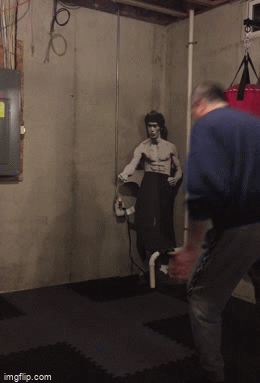
Balance is something that many older people have problems with. Fortunately, there are simple exercises that can help improve our body's balance systems. These exercises can be modified for virtually any age and fitness level so you don't have to wait for balance problems before you start doing them. Performing them before you develop balance issues to minimize the chance of this ever occurring seems like a better approach.
Consider that even standing in one spot requires our brain to receive information from sensors in different parts of our body that give it information about where we are in space. If our center of gravity changes, our brain receives information about this and triggers compensatory effects to re-establish our center of gravity in a way that maintains balance. One way that our brain determines our position in space is our visual system. When our eyes are open and we can see the "horizon" we know if we are positioned sideways or upright. Another system - the vestibular system - provides our brain with information sent from stuctures within our ears. This way, even with our eyes closed, we can tell if we are upright or sideways due to the effect of gravity on this system. Additionally, we have the somatosensory system which includes receptors in the joints of our spine and extremities, other musculoskeletal system structures, nerves in the skin, etc., which provide our brain with proprioceptive input to help detect if our weight is shifting as we stand and otherwise help us balance in different positions.
As our visual, vestibular and somatosensory systems begin to function less optimally over the years, balance problems may result. Using this simple explanation of how our balance system works, we can come up with an exercise that challenges our brain and balance systems by making it more difficult for them to do their job. It would obviously be more difficult to maintain balance in this circumstance but what would happen if we kept practicing this exercise and were able to improve our performance over time? This would mean that our system was improving in its ability to function, ultimately resulting in a better ability to balance. The great part is that this is very easy to do with one simple exercise!
Start by standing in a corner of a room, facing into the room with your back toward the corner. You should be near the corner WITHOUT TOUCHING either wall. Now try just closing your eyes and standing for 30 seconds. By eliminating the visual input that our balance system uses, we force it to rely more on the vestibular and somatosensory systems we discussed. This is still relatively easy for most people but if you have difficulty with it, just practice a little every day and you will improve. The reason you are standing with your back near the walls is that if you lose your balance, you will not fall backwards onto the floor. Now, practice standing on one foot. Try to get to the point that you can do it for at least 30 seconds on each side. Now try standing on one foot with your eyes closed. This is much harder for most people for the reasons we mentioned but if you get good at this you will really sharpen your balance system. How about standing on one leg with your foot in different positions without wobbling for 30 seconds then, with your eyes still closed, doing the same with the other foot? Athletes can try doing various sport related motions with their eyes closed. A karateka, for example, can try doing a kata with their eyes closed. Or, how about a slow motion high side kick switching from one leg to the other with eyes closed?! You get the point, the possiblities are endless and you can do a version appropriate for almost any age or level of athleticism. Just be sure to stay safe and consider any animals you may have in the house, keep them safe too! Remember that this is an exercise to help improve balance, don't try anything dangerous just to see if you can do it, be smart!
Improve Your Balance With This One Simple Exercise!
What About Cardiovascular Health?
The prevalence of cardiovascular disease and heart surgeries in our country reminds us of the importance of cardiovascular health, especially as we age. If we don't maintain our cardiovascular system, it makes it more difficult for our body to provide our tissues with oxygen. Less oxygen to our muscles, our brain, our heart and all other tissues not only decreases our physical and mental performance but may also increase our risk for life threatening cardiovascular events. Although we will discuss some exercises in this section to help improve and maintain our cardiovascular fitness, the importance of diet and its role in cardiovascular health cannot be overemphasized. As it is unlikely that you will fully overcome the negative effects of a terrible diet through exercise alone, please discuss your diet with your qualified health care providers and follow your cardiologist's recommendations with regard to any medications you should be on, as these factors are also vital in living a long, healthy, functional life. Having said that, are there any exercises we can do to further help improve and maintain our cardiovascular health and fitness? You bet!
Walking & Running
Running is one of the best ways to maintain cardiovascular fitness. However, many people have difficulty running. Perhaps they have joint issues that prevent high impact exercise, or perhaps their health status may not allow this level of intensity on the cardiovascular system. The good news is that just walking may still be very helpful! Although it may not provide some of the additional cardiovascular benefit that further increases in heart rate gives certain individuals, it is much safer and will still provide surprising benefits. To make it even easier to do, it does not have to be performed in a structured manner. Some people like to walk a certain distance each day for a period of time. This is fine but it seems that just tracking your "steps" to ensure you are getting 7,000-10,000 steps per day may be enough for a baseline level of fitness. Not 20,000? Up until recently it was thought that 20,000 steps per day were the target to shoot for and getting this number of steps is still great. However, a recent study showed that most of the benefit from walking could be achieved with the lower step number, with much less ADDITIONAL benefit by doing even more steps. Many people may not consider walking to be a cardiovascular exercise as it will usually not raise the heart rate to the level that is typically thought to provide these benefits. It is my belief that we should not look at exercise only from the perspective of these two extremes. The evidence shows that something is almost always MUCH better than nothing. If you are healthy enough to run and like running, then run. If you are not in a condition to run, or simply do not like running, then even a little walking will do you a lot more good than just sitting on a couch.
Exercise Bike
Perhaps you cannot get out for a walk. Maybe it is too hot or cold outside or perhaps you do not feel safe doing so. An exercise bike is a great option to get the blood circulating. The advantage of an exercise bike is that intensity may be modified for virtually any level of fitness while providing a low impact workout that is less stressful on joints than high impact exercise. Even people with certain spinal problems that make walking difficult - like spinal stenosis - may be able to tolerate a stationary bike. Be sure to discuss this with your qualified health care provider as other types of spinal problems - such as herniated discs - may be aggravated in the sitting position and an exercise bike may contraindicated. For some others, a recumbent exercise bike may be a good choice. Again, talk to your doctor to help choose your best option.
Dancing
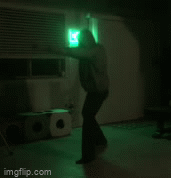
If you have read the above, you may be seeing a theme. The key is to get moving and stay moving for a period of time. This can be in a structured form such as going for a run or doing an exercise video each day. However, this may also be in a form that does not feel like exercise but still increases the heart rate and gets blood moving. If you have never tried dancing as exercise, you may be surprised at how much of a cardiovascular activity it can be. Try to get through an entire song at a pace you are comfortable with. You can do different types of dancing depending on your interests and abilities. Don't be fooled by thinking dancing isn't really exercise - a past study showed that competitive ballroom dancers reached heart rates over 170 beats per minute! Dancing and other activities that get you moving are a great way to stimulate your cardiovascular system while learning a new skill and developing new brain connections while improving balance and coordination all while having fun!
